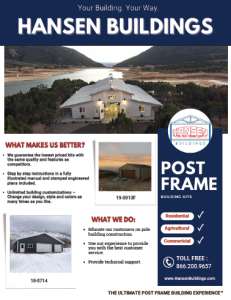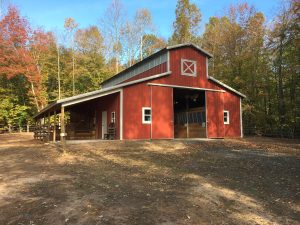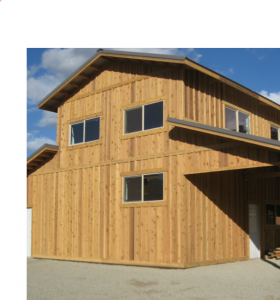Welcome to Ask the Pole Barn Guru – where you can ask questions about building topics, with answers posted on Mondays. With many questions to answer, please be patient to watch for yours to come up on a future Monday segment. If you want a quick answer, please be sure to answer with a “reply-able” email address.
Email all questions to: PoleBarnGuru@HansenPoleBuildings.com
DEAR POLE BARN GURU: Do you have any experience with SIPs? Would it be possible to construct a pole frame building with SIP panels for the roof and floor joists across the top of the building? This would create a full width storage area above without trusses. Matt in Coeur d’Alene, ID
DEAR MATT: I’ve actually never used SIPs (Structural Insulated Panels) personally, however I’ve been researching them and their application to pole building frames over the past few months as I believe they may have some applications.
For those unfamiliar with SIPs, they are structural facing material (think oriented strand board – OSB or plywood) with a foam core.
Using SIPs is probably not for the faint of pocketbook. Much of the cost, like a new pole building to begin with, is deciding you are going to do it at all. Once you have made the leap, you might as well go all the way. An R-16 SIP is going to run $4 to $4.50 per square foot, while TRIPLING the R-value only adds about $1.50 per square foot.
A SIP wall will offer about twice the R-value as an equally thick stud framed wall with fiberglass batt insulation.
The higher R-value SIP is also going to be able to span greater distances, however the thickness is going to have to be considered. I would surmise a fairly thick SIP panel would span 12 feet between supports under the majority of wind and snow load conditions. This is not going to eliminate the need for trusses, or other beams being required to support the SIPs, albeit without the need to have wall girts or roof purlins!
SIP panels of other than minimal dimensions are going to be heavy and will require lifting equipment. They also cannot be left exposed to the elements and require the use of appropriate underlayment between the panels and roofing and siding materials.
Let me know if you go this direction and how it works out for you.
Mike the Pole Barn Guru
DEAR POLE BARN GURU: I would like to know if you’re interested in building my new building? I have the prints and need a quote. I want r38 in ceiling and R19 in the walls. Let me know? I am attaching the plans. I am in the process of getting quotes for a heating and air system, if you want to quote that I am open to your thoughts. SHERRY IN MITCHELL, IN
DEAR SHERRY: We are interested in doing the design and providing the materials for just about any pole building.
We are not contractors and do not construct buildings for anyone, anywhere. We do work with builders in nearly every state, who may be able to provide assembly, or we can assist you in finding a builder on your own. We do not ever recommend any particular builder – so it will be up to you to thoroughly vet them. (Read how to check out a contractor here: https://www.hansenpolebuildings.com/blog/2013/07/contractor-6/)
One thing we do not do is to provide materials based upon structural designs provided by others. We most often find the plans to be either structurally under designed, or overkilled. Our services include complete structural drawings, where every member and connection is verified to be able to support the design loads. Our plans are always designed to Code and can be sealed by an engineer if you so choose.
We can most certainly design to meet the insulation R values you desire, and in many cases supply the insulation itself.
Mike the Pole Barn Guru
DEAR POLE BARN GURU: On your blog you say the best post footings are achieved by supporting the post 8″ above the bottom of the hole and filling the hole 24″ or so with concrete. What is the method of supporting the pole while placing concrete until the concrete sets. GAYLA in MOUNDS,IL
DEAR GAYLA: Stand the post in the bottom of the hole (column depth below grade) specified on the building plans) and align the exterior face as if the column were going to be concreted in – then pull it upwards 8” (leaving an 8” space below the column) and temporarily nail it to a purlin or other piece of lumber laid across the hole to keep it in this “finished” position. Pour the concrete – you can shovel or push it in and around the column with another stick of lumber so the mono-pour encases the pole. Once the poles are “set”, hammer the temporary piece of lumber (like a purlin) off the column –to use where it is designated. Sometimes I use two pieces of temporary bracing to support the column to be concreted in – so the pole is basically suspended in mid-air within the hole…until the day after concrete is poured. Remove temporary braces and reuse them. You won’t “hurt” the lumber used as temporary bracing.
Mike the Pole Barn Guru









